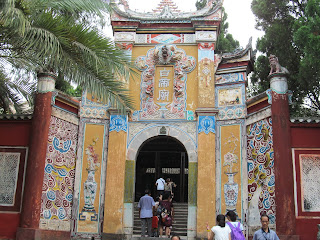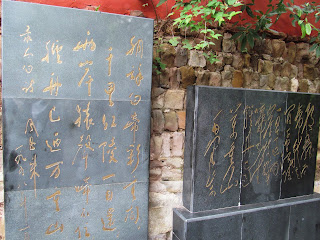I had
24 hours in Yichang because my chances of making the 1:24 train were iffy. As
it turned out, I probably couldn’t have made it, since we got to my downtown
hotel at 1:10. After checking in, I relaxed in the room for a couple hours.
Then I decided to go out to the river and to a park I saw on the map.
The
walk to the river turned out to be short—about ten minutes. There is a really
nice tree-lined walking path along the river with park areas between the street
and the river. I walked for over an hour. It was really hot—about 40o/101o.
There were a few men fishing—with poles, the big nets, and smaller nets.
 In one
park area there is a monument commemorating the Yichang Evacuation in 1938
during the anti-Japanese war. 30,000 people and 100,000 tons of war industry
equipment were evacuated to Chongqing over a four year period while the
Japanese continued to bomb. I hadn’t realized they came this far into the
country.
In one
park area there is a monument commemorating the Yichang Evacuation in 1938
during the anti-Japanese war. 30,000 people and 100,000 tons of war industry
equipment were evacuated to Chongqing over a four year period while the
Japanese continued to bomb. I hadn’t realized they came this far into the
country.
I
noticed a McDonald’s arch on a building across the street and decided to go for
some ice cream on my way back. I ended out getting a Flurry and sitting at a
table there for an hour. It’s the only store that is completed and open in the
building. And I think it’s not finished yet, as there are no walls around the
tables area and it looks like they aren’t cooking yet, only serving ice cream
items.
But I appreciated the Flurry and having a place to sit with a fan.
(another sign that it’s not finished, as I think it will have aircon when it’s
done)
Then I
headed back to the hotel and to find dinner. But I got sidetracked and stayed
along the river for over an hour longer. At 6:15, when I arrived at the hotel’s
street, I noticed that people were starting to get ready for the evening
crowds. Booths were being set up. A few stage backdrops with microphones were
up and people were starting to sing. People were starting to come out to walk.
People were swimming in the river. The exercise equipment was being used. So I
walked in the other direction for a while.
I watched a few men fishing with the
big and smaller nets. That process fascinates me. As time went on, the sidewalk
had a steady stream of people walking, some walking fast for exercise.
Then the
sun started setting; so I stopped and watched. When I walked back, there were
more people swimming and singing.
Then it
was time to find a place to eat. Tables and food displays were on the
sidewalks. When I crossed the street, there was a restaurant with food out that
I could point to to order. I asked the price of two items and then the woman
walked away. I waited for her to return, but she didn’t. Another woman was
standing there and not offering to take my order. So I left. Around the corner
there was a smaller, similar place with tables and food on display. The man
there was very helpful and willing to try to serve this foreigner. When I asked
about items, he showed them to me on the menu and pointed to the prices. I
asked, with the assistance of my phone dictionary, about a small portion, and
the man got out a small bowl to show me. It looked the right size. I ordered
the crab, which he had indicated was delicious, and the boiled soy beans in the
pods, which I really like. They seated me inside where it was cooler.
 First
the soy beans came. I was surprised that they’d been cooked more and had chili
pepper sprinkled on them. But this was OK, because with such foods the inside
is not affected by the chili; so I could eat the beans. Then the crab arrived.
It was a big dish and had been cooked with some vegetables and chili sauce.
This was not looking good. I hadn’t occurred to me to ask for not spicy, as
both the crab and soy beans were already cooked. But, again, the part of the
crab that is eaten is inside the shell and not affected by the chili. So I
could eat it and just not eat the vegetables. The woman brought plastic gloves
for me wear when eating. After I ate a couple, I realized that they were not
crabs. They just looked like crabs the way they were folded in the display. I
realized that they were actually small lobsters, which never would have
occurred to me because I had no idea lobsters that small were eaten. As I was
eating, the woman came and made sure I knew that there is meat inside the claws
as well as at the tail. But, since they were cooked in the spicy sauce and the
only way to crack the claws was with my teeth, which meant putting them in my
mouth, I couldn’t eat the claw meat. And there was so much food that I knew I
would be doing well to eat all the tails. The tail meat was about an inch long
and was tasty.
First
the soy beans came. I was surprised that they’d been cooked more and had chili
pepper sprinkled on them. But this was OK, because with such foods the inside
is not affected by the chili; so I could eat the beans. Then the crab arrived.
It was a big dish and had been cooked with some vegetables and chili sauce.
This was not looking good. I hadn’t occurred to me to ask for not spicy, as
both the crab and soy beans were already cooked. But, again, the part of the
crab that is eaten is inside the shell and not affected by the chili. So I
could eat it and just not eat the vegetables. The woman brought plastic gloves
for me wear when eating. After I ate a couple, I realized that they were not
crabs. They just looked like crabs the way they were folded in the display. I
realized that they were actually small lobsters, which never would have
occurred to me because I had no idea lobsters that small were eaten. As I was
eating, the woman came and made sure I knew that there is meat inside the claws
as well as at the tail. But, since they were cooked in the spicy sauce and the
only way to crack the claws was with my teeth, which meant putting them in my
mouth, I couldn’t eat the claw meat. And there was so much food that I knew I
would be doing well to eat all the tails. The tail meat was about an inch long
and was tasty.
Sunday morning I planned to
go to a folklore center I’d read about, but when I asked the receptionist about
it, I learned that it would take over an hour to get there, and I didn’t have
time to do that. This receptionist spoke some English, which was helpful. When
I asked about another place to go, she suggested that I go to the mall nearby
and go shopping. I was not interested in that and headed back to the river. It
was already very hot at 9:30. I walked the direction I’d gone in the evening. I
was surprised to see a lot of people out walking, possibly because it was
Sunday. Several people were doing their tai chi under trees. Two men were
boxing. The only sign of the Saturday night activity in the area was a truck
that was overfilled with trash and onto which two women were unloading more
trash. I passed a pagoda
and saw a
church across the street that I thought I should check out.
The worship room
was very simple with a cross and a menorah and two peace doves on the altar.
Then it was time to head back to check out and head for the train station. I
was glad to have this extra time along the river.
On the way to the hotel, I
had lunch at a place with vegetables in baskets. I was given a dish on which to
put the vegetables I wanted. When the man didn’t think I’d put enough on the
dish, he added more. Everything was stir fried to make a delicious lunch. I
like places like that.
I barely made my train. When
I checked out, I learned that the station is farther than indicated on the
booking website and that I barely had time to get there. When I arrived, I got
in line in front of a few other people, Chinese style. By the time I got to the
gate for my train, it was closed. Not quite panicking, I walked quickly and
showed my ticket to a few people and asked where it was; they just shrugged.
Then I saw a man in a uniform and showed him my ticket. He indicated for me to
follow him and made a call on his walkie-talkie. We went to the central gate
where another man made a call on his walkie-talkie and told me “gate 9.” Two
other people followed me and we ran down the corridor to the gate, which was,
of course, the last one. Then they ran up the stairs. I couldn’t do that, but I
went up as fast as I could. When I got to the train, I saw that a person was
standing outside each car and realized that the train wasn’t going to leave
with me walking fast to my car. They wouldn’t let me get onto another car and
walk through. I was so relieved when I arrived at my seat. And after all that,
the train left 15 minutes late. My seat turned out to be a soft sleeper. I’m
not sure how that happened. I just paid for the ticket that was given to me.
But it was nice to be able to lie down and put my feet up on my bags and be
comfortable. I had a bottom bunk. There are six bunks in a room. A conductor
came and took our train tickets, giving us a plastic card with the number of
the car and bed. Shortly before we arrived, he returned to exchange the card
for the ticket. I had no idea what that was about. When I asked my guide later,
she explained that the card is so they know where you are getting off and can
wake you up.




























































